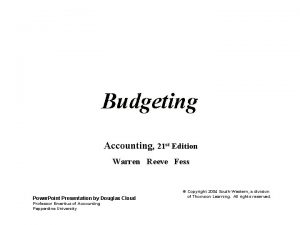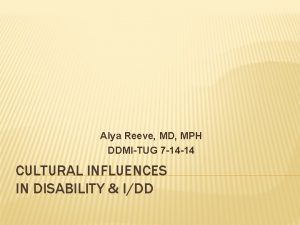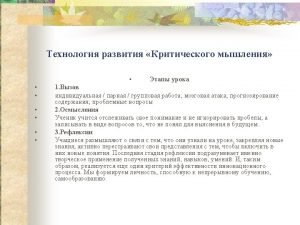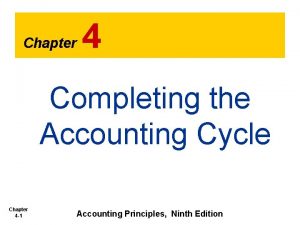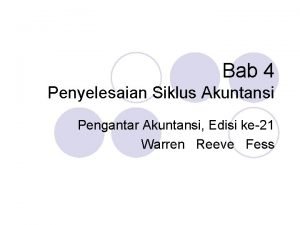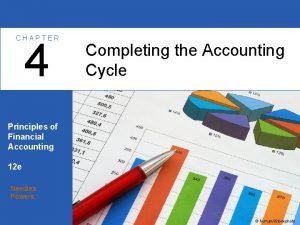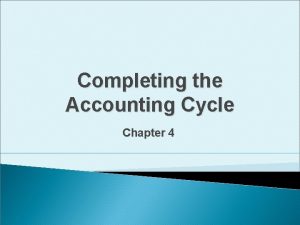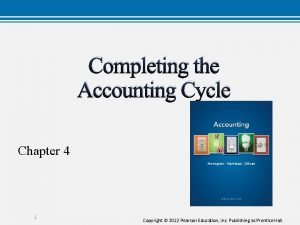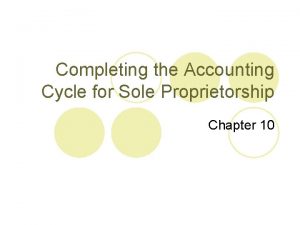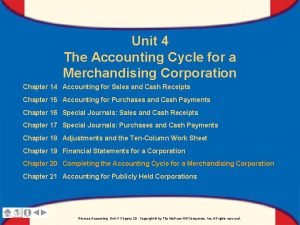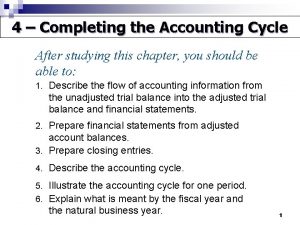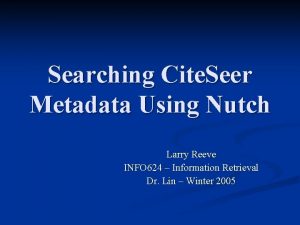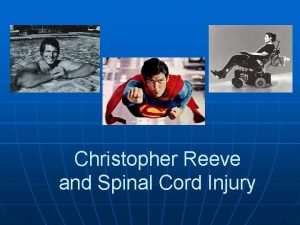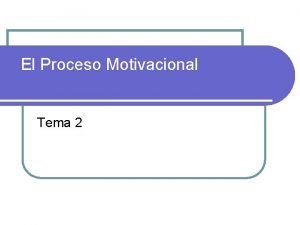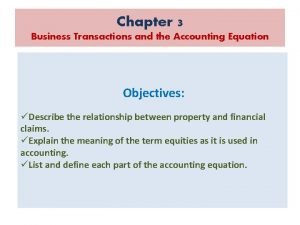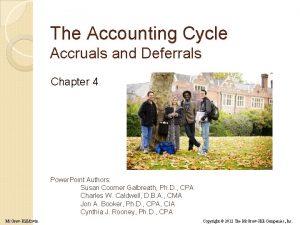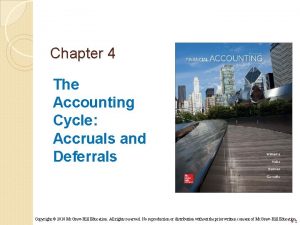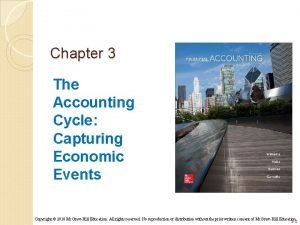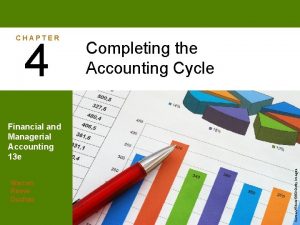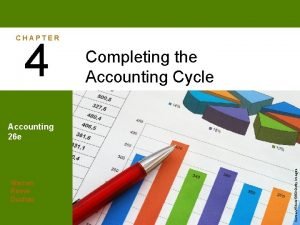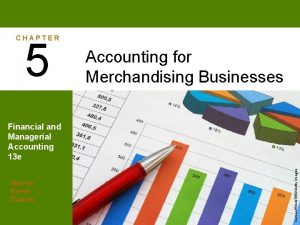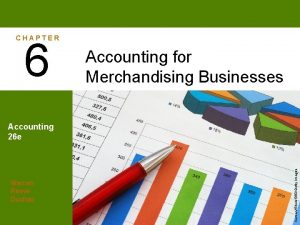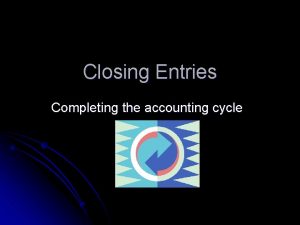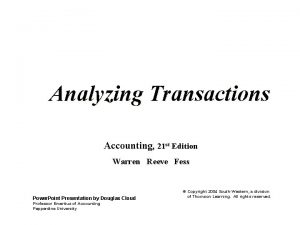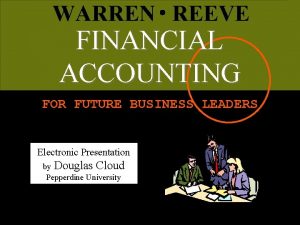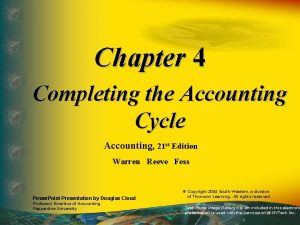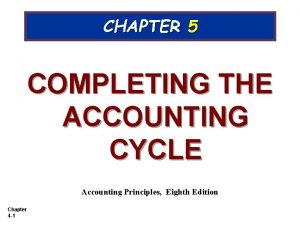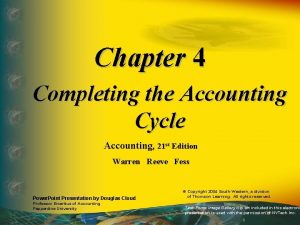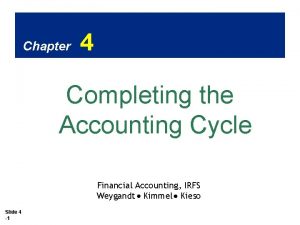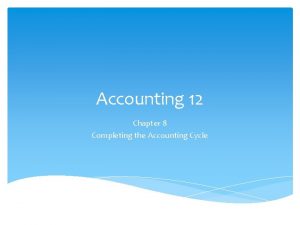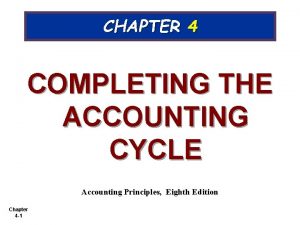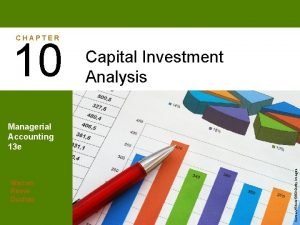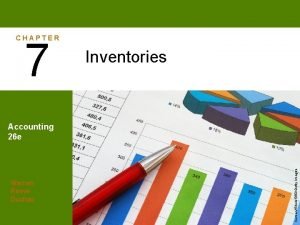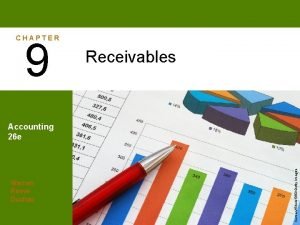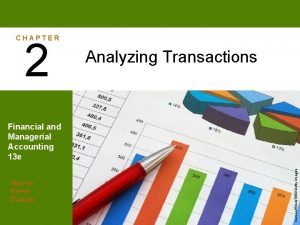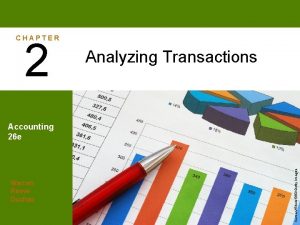CHAPTER 4 Completing the Accounting Cycle Warren Reeve











































































- Slides: 75

CHAPTER 4 Completing the Accounting Cycle Warren Reeve Duchac human/i. Stock/360/Getty Images Financial and Managerial Accounting 13 e

Learning Objectives • • LO 1: Describe the flow of accounting information from the unadjusted trial balance into the adjusted trial balance and financial statements. LO 2: Prepare financial statements from adjusted account balances. LO 3: Prepare closing entries. LO 4: Describe the accounting cycle. LO 5: Illustrate the accounting cycle for one period. LO 6: Explain what is meant by the fiscal year and the natural business year. LO 7: Describe and illustrate the use of working capital and the current ratio in evaluating a company’s financial condition. © 2016 Cengage Learning. All Rights Reserved. May not be scanned, copied or duplicated, or posted to a publicly accessible website, in whole or in part.

End-of-Period Spreadsheet and Flow of Accounting Data—Net. Solutions © 2016 Cengage Learning. All Rights Reserved. May not be scanned, copied or duplicated, or posted to a publicly accessible website, in whole or in part.

Flow of Accounting Information (slide 1 of 5) End-of-Period Spreadsheet (Work Sheet) Unadjusted Trial Balance A ccounts • Dr Cr Adjustments Cr Dr Adjusted Trial Balance Dr Cr Account balances are listed in the Unadjusted Trial Balance columns using the ending balances found in the general ledger. © 2016 Cengage Learning. All Rights Reserved. May not be scanned, copied or duplicated, or posted to a publicly accessible website, in whole or in part.

Flow of Accounting Information (slide 2 of 5) End-of-Period Spreadsheet (Work Sheet) Unadjusted Trial Balance A ccounts • Dr Cr Adjustments Cr Dr Adjusted Trial Balance Dr Cr Adjustments are entered here. Two possibilities: o o Deferrals – Existing balances are changed. Accruals – New information is entered © 2016 Cengage Learning. All Rights Reserved. May not be scanned, copied or duplicated, or posted to a publicly accessible website, in whole or in part.

Flow of Accounting Information (slide 3 of 5) End-of-Period Spreadsheet (Work Sheet) Unadjusted Trial Balance A ccounts • Dr Cr Adjustments Cr Dr Adjusted Trial Balance Dr Cr Adjustments are added to or subtracted from the amounts in the Unadjusted Trial Balance columns. Account balances are now adjusted. © 2016 Cengage Learning. All Rights Reserved. May not be scanned, copied or duplicated, or posted to a publicly accessible website, in whole or in part.

Flow of Accounting Information (slide 4 of 5) End-of-Period Spreadsheet (Work Sheet) Adjusted Trial Balance A ccounts • Dr Cr Balance Sheet Income Statement Cr Dr Dr Cr Amounts for revenues and expenses in the Adjusted Trial Balance columns are extended to the Income Statement columns. © 2016 Cengage Learning. All Rights Reserved. May not be scanned, copied or duplicated, or posted to a publicly accessible website, in whole or in part.

Flow of Accounting Information (slide 5 of 5) End-of-Period Spreadsheet (Work Sheet) Adjusted Trial Balance A ccounts • Dr Cr Income Statement Cr Dr Balance Sheet Dr Cr The amounts for assets, liabilities, common stock, and dividends in the Adjusted Trial Balance columns are extended to the Balance Sheet columns. © 2016 Cengage Learning. All Rights Reserved. May not be scanned, copied or duplicated, or posted to a publicly accessible website, in whole or in part.

Example Exercise Flow of Accounts into Financial Statements The balances for the accounts that follow appear in the Adjusted Trial Balance columns of the end-of-period spreadsheet. Indicate whether each account would flow into the income statement, retained earnings statement, or balance sheet. 1. Office Equipment 2. Utilities Expense 3. Accumulated Depreciation— Equipment 4. Unearned Rent 5. Fees Earned 6. Dividends 7. Rent Revenue 8. Supplies 1. 2. 3. 4. 5. 6. 7. 8. Balance sheet Income statement Retained earnings statement Income statement Balance sheet © 2016 Cengage Learning. All Rights Reserved. May not be scanned, copied or duplicated, or posted to a publicly accessible website, in whole or in part.

Income Statement • • The income statement is prepared directly from the Adjusted Trial Balance columns of the end-of -period spreadsheet (work sheet), beginning with fees earned of $16, 840. The expenses in the income statement are listed in order of size, beginning with the larger items. However, Miscellaneous Expense is always the last account listed, regardless of its amount. © 2016 Cengage Learning. All Rights Reserved. May not be scanned, copied or duplicated, or posted to a publicly accessible website, in whole or in part.

Financial Statements—Net. Solutions: Income Statement to retained earnings statement © 2016 Cengage Learning. All Rights Reserved. May not be scanned, copied or duplicated, or posted to a publicly accessible website, in whole or in part.

Retained Earnings Statement • • The first item normally presented on the retained earnings statement is the balance of the retained earnings account at the beginning of the period. Net income (or net loss) and the dividends account balance are used to determine the ending retained earnings account balance. © 2016 Cengage Learning. All Rights Reserved. May not be scanned, copied or duplicated, or posted to a publicly accessible website, in whole or in part.

Financial Statements—Net. Solutions: Retained Earnings Statement from the income statement to the balance sheet © 2016 Cengage Learning. All Rights Reserved. May not be scanned, copied or duplicated, or posted to a publicly accessible website, in whole or in part.

Example Exercise Retained Earnings Statement (slide 1 of 2) Zack Gaddis owns and operates Gaddis Employment Services. On January 1, 2015, Retained Earnings had a balance of $186, 000. During the year, Zack invested an additional $40, 000 in the business in exchange for common stock. In addition, dividends of $25, 000 were paid during the year. For the year ended December 31, 2015, Gaddis Employment Services reported a net income of $18, 750. Prepare a retained earnings statement for the year ended December 31, 2015. © 2016 Cengage Learning. All Rights Reserved. May not be scanned, copied or duplicated, or posted to a publicly accessible website, in whole or in part.

Example Exercise Retained Earnings Statement (slide 2 of 2) © 2016 Cengage Learning. All Rights Reserved. May not be scanned, copied or duplicated, or posted to a publicly accessible website, in whole or in part.

Balance Sheet • The balance sheet is prepared directly from the • Adjusted Trial Balance columns of the end-ofperiod spreadsheet, beginning with Cash of $2, 065. A classified balance sheet is a balance sheet that is expanded by adding subsections for assets and liabilities. o o Assets are commonly divided into two sections on the balance sheet: (1) current assets and (2) property, plant, and equipment. Liabilities are commonly divided into two sections on the balance sheet: (1) current liabilities and (2) longterm liabilities. © 2016 Cengage Learning. All Rights Reserved. May not be scanned, copied or duplicated, or posted to a publicly accessible website, in whole or in part.

Financial Statements—Net. Solutions: Balance Sheet from the retained earnings statement © 2016 Cengage Learning. All Rights Reserved. May not be scanned, copied or duplicated, or posted to a publicly accessible website, in whole or in part.

Current Assets (slide 1 of 2) • • Cash and other assets that are expected to be converted into cash or sold or used up usually within one year or less, through the normal operations of the business, are called current assets. Current assets include: o o o Cash Accounts receivable Notes receivable Supplies Other prepaid expenses © 2016 Cengage Learning. All Rights Reserved. May not be scanned, copied or duplicated, or posted to a publicly accessible website, in whole or in part.

Current Assets (slide 2 of 2) • • Notes receivable are written promises by the customer to pay the amount of the note and interest. Like accounts receivable, notes receivable are amounts that customers owe, but they are more formal than accounts receivable. Notes receivable and accounts receivable are current assets because they are usually converted to cash within one year or less. © 2016 Cengage Learning. All Rights Reserved. May not be scanned, copied or duplicated, or posted to a publicly accessible website, in whole or in part.

Property, Plant, and Equipment • Property, plant, and equipment (also called fixed assets or plant assets) include land assets that depreciate over a period of time. o Assets that depreciate over time include: § Equipment § Machinery § Buildings © 2016 Cengage Learning. All Rights Reserved. May not be scanned, copied or duplicated, or posted to a publicly accessible website, in whole or in part.

Current Liabilities • • Amounts the business owes to creditors that will be due within a short time (usually one year or less) and that are to be paid out of current assets are called current liabilities. Current liabilities include: o o o Accounts payable Notes payable Wages payable Interest payable Unearned fees © 2016 Cengage Learning. All Rights Reserved. May not be scanned, copied or duplicated, or posted to a publicly accessible website, in whole or in part.

Long-Term Liabilities • Amounts the business owes to creditors that will not be due for a long time (usually more than one year) are called long-term liabilities. © 2016 Cengage Learning. All Rights Reserved. May not be scanned, copied or duplicated, or posted to a publicly accessible website, in whole or in part.

Stockholders’ Equity • • • Stockholders’ equity is the stockholders’ right to the assets of the business. It is presented on the balance sheet below the liabilities section. Stockholders’ equity is added to the total liabilities, and this total must be equal to the total assets. © 2016 Cengage Learning. All Rights Reserved. May not be scanned, copied or duplicated, or posted to a publicly accessible website, in whole or in part.

Example Exercise Classified Balance Sheet The following accounts appear in an adjusted trial balance of Hindsight Consulting. Indicate whether each account would be reported in the (a) current asset; (b) property, plant, and equipment; (c) current liability; (d) long -term liability; or (e) stockholders’ equity section of the December 31, 2015, balance sheet of Hindsight Consulting. 1. Common Stock 2. Notes Receivable (due in six months) 3. Notes Payable (due in 10 years) 4. Land 5. Cash 6. Unearned Rent (three months) 7. Accumulated Depreciation— Equipment 8. Accounts Payable 1. 2. 3. 4. 5. 6. 7. 8. Stockholders’ equity Current asset Long-term liability Property, plant, and equipment Current asset Current liability Property, plant, and equipment Current liability © 2016 Cengage Learning. All Rights Reserved. May not be scanned, copied or duplicated, or posted to a publicly accessible website, in whole or in part.

Permanent Accounts • • • Accounts that are relatively permanent from year to year are called permanent accounts or real accounts. The balances of these accounts are carried forward from year to year. This includes accounts reported on the balance sheet. © 2016 Cengage Learning. All Rights Reserved. May not be scanned, copied or duplicated, or posted to a publicly accessible website, in whole or in part.

Temporary Accounts • • • Accounts that report amounts for only one period are called temporary accounts or nominal accounts. Temporary accounts are not carried forward from year to year because they relate to only one period. This includes all accounts reported on the income statement as well as the dividends account, which is reported on the retained earnings statement. © 2016 Cengage Learning. All Rights Reserved. May not be scanned, copied or duplicated, or posted to a publicly accessible website, in whole or in part.

The Closing Process © 2016 Cengage Learning. All Rights Reserved. May not be scanned, copied or duplicated, or posted to a publicly accessible website, in whole or in part.

Closing Entries (slide 1 of 3) • • To report amounts for only one period, temporary accounts should have zero balances at the beginning of the next period. To achieve this, temporary account balances are transferred to permanent accounts at the end of the accounting period through journal entries. The entries that transfer these balances are called closing entries. The transfer process is called the closing process and is sometimes referred to as closing the books. After the closing entries are posted, all of the temporary accounts have zero balances. © 2016 Cengage Learning. All Rights Reserved. May not be scanned, copied or duplicated, or posted to a publicly accessible website, in whole or in part.

Closing Entries (slide 2 of 3) • • • Income Summary is a temporary account that is only used during the closing process. At the beginning of the closing process, Income Summary has no balance. During the closing process, revenue and expense accounts are cleared by debiting or crediting Income Summary for their amounts. Because it has the effect of clearing the revenue and expense accounts of their balances, Income Summary is sometimes called a clearing account. The balance of Income Summary (net income or net loss) is transferred to the retained earnings account. At the end of the closing process, the Income Summary account will have a zero balance. © 2016 Cengage Learning. All Rights Reserved. May not be scanned, copied or duplicated, or posted to a publicly accessible website, in whole or in part.

Closing Entries (slide 3 of 3) • The four closing entries required in the closing process are as follows: 1. Debit each revenue account for its balance and credit Income Summary for the total revenue. 2. Credit each expense account for its balance and debit Income Summary for the total expenses. 3. Debit Income Summary for its balance (net income) and credit the retained earnings account. (In the case of a net loss, credit Income Summary for its balance and debit the retained earnings account. ) 4. Debit the retained earnings account for the balance of the dividends account and credit the dividends account. © 2016 Cengage Learning. All Rights Reserved. May not be scanned, copied or duplicated, or posted to a publicly accessible website, in whole or in part.

Flowchart of Closing Entries for Net. Solutions © 2016 Cengage Learning. All Rights Reserved. May not be scanned, copied or duplicated, or posted to a publicly accessible website, in whole or in part.

Closing Entries, Net. Solutions © 2016 Cengage Learning. All Rights Reserved. May not be scanned, copied or duplicated, or posted to a publicly accessible website, in whole or in part.

Ledger, Net. Solutions (slide 1 of 5) © 2016 Cengage Learning. All Rights Reserved. May not be scanned, copied or duplicated, or posted to a publicly accessible website, in whole or in part.

Ledger, Net. Solutions (slide 2 of 5) © 2016 Cengage Learning. All Rights Reserved. May not be scanned, copied or duplicated, or posted to a publicly accessible website, in whole or in part.

Ledger, Net. Solutions (slide 3 of 5) © 2016 Cengage Learning. All Rights Reserved. May not be scanned, copied or duplicated, or posted to a publicly accessible website, in whole or in part.

Ledger, Net. Solutions (slide 4 of 5) © 2016 Cengage Learning. All Rights Reserved. May not be scanned, copied or duplicated, or posted to a publicly accessible website, in whole or in part.

Ledger, Net. Solutions (slide 5 of 5) © 2016 Cengage Learning. All Rights Reserved. May not be scanned, copied or duplicated, or posted to a publicly accessible website, in whole or in part.

Example Exercise Closing Entries (slide 1 of 2) After the accounts have been adjusted at July 31, the end of the fiscal year, the following balances are taken from the ledger of Cabriolet Services Co. : Journalize the four entries required to close the accounts. © 2016 Cengage Learning. All Rights Reserved. May not be scanned, copied or duplicated, or posted to a publicly accessible website, in whole or in part.

Example Exercise Closing Entries (slide 2 of 2) © 2016 Cengage Learning. All Rights Reserved. May not be scanned, copied or duplicated, or posted to a publicly accessible website, in whole or in part.

Post-Closing Trial Balance • • A post-closing trial balance is prepared after the closing entries have been posted. The purpose of the post-closing (after closing) trial balance is to verify that the ledger is in balance at the beginning of the next period. © 2016 Cengage Learning. All Rights Reserved. May not be scanned, copied or duplicated, or posted to a publicly accessible website, in whole or in part.

Post-Closing Trial Balance, Net. Solutions © 2016 Cengage Learning. All Rights Reserved. May not be scanned, copied or duplicated, or posted to a publicly accessible website, in whole or in part.

Accounting Cycle (slide 1 of 2) • The accounting process that begins with analyzing and journalizing transactions and ends with the post-closing trial balance is called the accounting cycle. © 2016 Cengage Learning. All Rights Reserved. May not be scanned, copied or duplicated, or posted to a publicly accessible website, in whole or in part.

Accounting Cycle (slide 2 of 2) • The steps in the accounting cycle are as follows: o o o o o Step 1. Transactions are analyzed and recorded in the journal. Step 2. Transactions are posted to the ledger. Step 3. An unadjusted trial balance is prepared. Step 4. Adjustment data are assembled analyzed. Step 5. An optional end-of-period spreadsheet is prepared. Step 6. Adjusting entries are journalized and posted to the ledger. Step 7. An adjusted trial balance is prepared. Step 8. Financial statements are prepared. Step 9. Closing entries are journalized and posted to the ledger. Step 10. A post-closing trial balance is prepared. © 2016 Cengage Learning. All Rights Reserved. May not be scanned, copied or duplicated, or posted to a publicly accessible website, in whole or in part.

Example Exercise Accounting Cycle From the following list of steps in the accounting cycle, identify what two steps are missing: a. Transactions are analyzed and recorded in the journal. b. Transactions are posted to the ledger. c. Adjustment data are assembled analyzed. d. An optional end-of-period spreadsheet is prepared. e. Adjusting entries are journalized and posted to the ledger. f. Financial statements are prepared. g. Closing entries are journalized and posted to the ledger. h. A post-closing trial balance is prepared. © 2016 Cengage Learning. All Rights Reserved. May not be scanned, copied or duplicated, or posted to a publicly accessible website, in whole or in part.

Accounting Cycle © 2016 Cengage Learning. All Rights Reserved. May not be scanned, copied or duplicated, or posted to a publicly accessible website, in whole or in part.

Illustration of the Accounting Cycle • The following slides will provide an illustration of the accounting cycle for Kelly Consulting. o Chart of Accounts o Journal Entries o Unadjusted Trial Balance o End-of-Period Spreadsheet o Adjusting Entries o Adjusted Trial Balance o Financial Statements o Closing Entries o Post-Closing Trial Balance o Ledger © 2016 Cengage Learning. All Rights Reserved. May not be scanned, copied or duplicated, or posted to a publicly accessible website, in whole or in part.

Chart of Accounts for Kelly Consulting © 2016 Cengage Learning. All Rights Reserved. May not be scanned, copied or duplicated, or posted to a publicly accessible website, in whole or in part.

Journal Entries for April, Kelly Consulting (slide 1 of 3) © 2016 Cengage Learning. All Rights Reserved. May not be scanned, copied or duplicated, or posted to a publicly accessible website, in whole or in part.

Journal Entries for April, Kelly Consulting (slide 2 of 3) © 2016 Cengage Learning. All Rights Reserved. May not be scanned, copied or duplicated, or posted to a publicly accessible website, in whole or in part.

Journal Entries for April, Kelly Consulting (slide 3 of 3) © 2016 Cengage Learning. All Rights Reserved. May not be scanned, copied or duplicated, or posted to a publicly accessible website, in whole or in part.

Unadjusted Trial Balance, Kelly Consulting © 2016 Cengage Learning. All Rights Reserved. May not be scanned, copied or duplicated, or posted to a publicly accessible website, in whole or in part.

End-of-Period Spreadsheet, Kelly Consulting © 2016 Cengage Learning. All Rights Reserved. May not be scanned, copied or duplicated, or posted to a publicly accessible website, in whole or in part.

Adjusting Entries, Kelly Consulting © 2016 Cengage Learning. All Rights Reserved. May not be scanned, copied or duplicated, or posted to a publicly accessible website, in whole or in part.

Adjusted Trial Balance, Kelly Consulting © 2016 Cengage Learning. All Rights Reserved. May not be scanned, copied or duplicated, or posted to a publicly accessible website, in whole or in part.

Financial Statements, Kelly Consulting: Income Statement © 2016 Cengage Learning. All Rights Reserved. May not be scanned, copied or duplicated, or posted to a publicly accessible website, in whole or in part.

Financial Statements, Kelly Consulting: Retained Earnings Statement © 2016 Cengage Learning. All Rights Reserved. May not be scanned, copied or duplicated, or posted to a publicly accessible website, in whole or in part.

Financial Statements, Kelly Consulting: Balance Sheet © 2016 Cengage Learning. All Rights Reserved. May not be scanned, copied or duplicated, or posted to a publicly accessible website, in whole or in part.

Closing Entries, Kelly Consulting © 2016 Cengage Learning. All Rights Reserved. May not be scanned, copied or duplicated, or posted to a publicly accessible website, in whole or in part.

Post-Closing Trial Balance, Kelly Consulting © 2016 Cengage Learning. All Rights Reserved. May not be scanned, copied or duplicated, or posted to a publicly accessible website, in whole or in part.

Ledger, Kelly Consulting (slide 1 of 4) © 2016 Cengage Learning. All Rights Reserved. May not be scanned, copied or duplicated, or posted to a publicly accessible website, in whole or in part.

Ledger, Kelly Consulting (slide 2 of 4) © 2016 Cengage Learning. All Rights Reserved. May not be scanned, copied or duplicated, or posted to a publicly accessible website, in whole or in part.

Ledger, Kelly Consulting (slide 3 of 4) © 2016 Cengage Learning. All Rights Reserved. May not be scanned, copied or duplicated, or posted to a publicly accessible website, in whole or in part.

Ledger, Kelly Consulting (slide 4 of 4) © 2016 Cengage Learning. All Rights Reserved. May not be scanned, copied or duplicated, or posted to a publicly accessible website, in whole or in part.

Fiscal Year • • • The annual accounting period adopted by a business is known as its fiscal year. Fiscal years begin with the first day of the month selected and end on the last day of the following twelfth month. When a corporation adopts a fiscal year that ends when business activities have reached the lowest point in its annual operating cycle, such a fiscal year is called the natural business year. © 2016 Cengage Learning. All Rights Reserved. May not be scanned, copied or duplicated, or posted to a publicly accessible website, in whole or in part.

Financial History of a Business © 2016 Cengage Learning. All Rights Reserved. May not be scanned, copied or duplicated, or posted to a publicly accessible website, in whole or in part.

Financial Analysis and Interpretation: Working Capital and Current Ratio • • • The ability to convert assets into cash is called liquidity. The ability of a business to pay its debts is called solvency. Two financial measures for evaluating a business’s short-term liquidity and solvency are working capital and the current ratio. © 2016 Cengage Learning. All Rights Reserved. May not be scanned, copied or duplicated, or posted to a publicly accessible website, in whole or in part.

Financial Analysis and Interpretation: Working Capital (slide 1 of 2) • • Working capital is the excess of the current assets of a business over its current liabilities. Working capital is computed as follows: Working Capital = Current Assets – Current Liabilities • A positive working capital implies that the business is able to pay its current liabilities and is solvent. © 2016 Cengage Learning. All Rights Reserved. May not be scanned, copied or duplicated, or posted to a publicly accessible website, in whole or in part.

Financial Analysis and Interpretation: Working Capital (slide 2 of 2) • Net. Solutions’ working capital at the end of 2015 is computed as follows: © 2016 Cengage Learning. All Rights Reserved. May not be scanned, copied or duplicated, or posted to a publicly accessible website, in whole or in part.

Financial Analysis and Interpretation: Current Ratio (slide 1 of 2) • • The current ratio is another means of expressing the relationship between current assets and current liabilities. The current ratio is computed by dividing current assets by current liabilities, as follows: Current Assets Current Ratio Current Liabilities = © 2016 Cengage Learning. All Rights Reserved. May not be scanned, copied or duplicated, or posted to a publicly accessible website, in whole or in part.

Financial Analysis and Interpretation: Current Ratio (slide 2 of 2) • The current ratio for Net. Solutions at the end of 2015 is computed as follows: © 2016 Cengage Learning. All Rights Reserved. May not be scanned, copied or duplicated, or posted to a publicly accessible website, in whole or in part.

Example Exercise Working Capital and Current Ratio Current assets and current liabilities for Fortson Company follow: a. Determine the working capital and current ratio for 2016 and 2015. b. Does the change in the current ratio from 2015 to 2016 indicate a favorable or an unfavorable trend? © 2016 Cengage Learning. All Rights Reserved. May not be scanned, copied or duplicated, or posted to a publicly accessible website, in whole or in part.

Appendix 1: End-of-Period Spreadsheet • • Spreadsheets are usually prepared by using a computer program such as Microsoft’s Excel®. Some accountants prefer to expand the end-ofperiod spreadsheet to include financial statement columns. © 2016 Cengage Learning. All Rights Reserved. May not be scanned, copied or duplicated, or posted to a publicly accessible website, in whole or in part.

Appendix 1: Steps in Preparing an Expanded End-of-Period Spreadsheet • • • Step 1. Enter the title. Step 2. Enter the unadjusted trial balance. Step 3. Enter the adjustments. Step 4. Enter the adjusted trial balance. Step 5. Extend the accounts to the Income Statement and Balance Sheet columns. Step 6. Total the Income Statement and Balance Sheet columns, compute the net income or net loss, and complete the spreadsheet. © 2016 Cengage Learning. All Rights Reserved. May not be scanned, copied or duplicated, or posted to a publicly accessible website, in whole or in part.

Completed Spreadsheet with Net Income Shown © 2016 Cengage Learning. All Rights Reserved. May not be scanned, copied or duplicated, or posted to a publicly accessible website, in whole or in part.

Appendix 1: Preparing the Financial Statements from the Spreadsheet • • The spreadsheet can be used to prepare the income statement, the retained earnings statement, and the balance sheet. When a spreadsheet is used, the adjusting and closing entries are normally not journalized or posted until after the spreadsheet and financial statements have been prepared. © 2016 Cengage Learning. All Rights Reserved. May not be scanned, copied or duplicated, or posted to a publicly accessible website, in whole or in part.
 Warren reeve fess accounting edition 21
Warren reeve fess accounting edition 21 Alya reeve
Alya reeve Alya reeve
Alya reeve Completion of the accounting cycle
Completion of the accounting cycle Chapter 4 completing the accounting cycle
Chapter 4 completing the accounting cycle Chapter 4 completing the accounting cycle
Chapter 4 completing the accounting cycle Chapter 4 completing the accounting cycle
Chapter 4 completing the accounting cycle Completing the accounting cycle chapter 4
Completing the accounting cycle chapter 4 Chapter 4 completing the accounting cycle
Chapter 4 completing the accounting cycle Journal entries of sole proprietorship
Journal entries of sole proprietorship General ledger merchandising
General ledger merchandising Post closing trial balance
Post closing trial balance English reeve highline
English reeve highline Larry reeve
Larry reeve Christopher reeve spinal cord injury level
Christopher reeve spinal cord injury level El proceso motivacional
El proceso motivacional Christopher reeve ventilator
Christopher reeve ventilator Canterbury tales satire
Canterbury tales satire Arran reeve
Arran reeve Dr elizabeth reeve
Dr elizabeth reeve Problem 3-4 classifying accounts answers
Problem 3-4 classifying accounts answers Intermediate accounting chapter 1
Intermediate accounting chapter 1 Chapter 4 the accounting cycle accruals and deferrals
Chapter 4 the accounting cycle accruals and deferrals Chapter 4 the accounting cycle accruals and deferrals
Chapter 4 the accounting cycle accruals and deferrals Chapter 3 accounting cycle
Chapter 3 accounting cycle Accounting chapter 3
Accounting chapter 3 Chapter 5 two-cycle and four-cycle engines answers
Chapter 5 two-cycle and four-cycle engines answers Chapter 18:3 completing job application forms
Chapter 18:3 completing job application forms Chapter 17:1 developing job-keeping skills
Chapter 17:1 developing job-keeping skills Hình ảnh bộ gõ cơ thể búng tay
Hình ảnh bộ gõ cơ thể búng tay Lp html
Lp html Bổ thể
Bổ thể Tỉ lệ cơ thể trẻ em
Tỉ lệ cơ thể trẻ em Chó sói
Chó sói Tư thế worms-breton
Tư thế worms-breton Bài hát chúa yêu trần thế alleluia
Bài hát chúa yêu trần thế alleluia Môn thể thao bắt đầu bằng chữ f
Môn thể thao bắt đầu bằng chữ f Thế nào là hệ số cao nhất
Thế nào là hệ số cao nhất Các châu lục và đại dương trên thế giới
Các châu lục và đại dương trên thế giới Công của trọng lực
Công của trọng lực Trời xanh đây là của chúng ta thể thơ
Trời xanh đây là của chúng ta thể thơ Mật thư tọa độ 5x5
Mật thư tọa độ 5x5 101012 bằng
101012 bằng độ dài liên kết
độ dài liên kết Các châu lục và đại dương trên thế giới
Các châu lục và đại dương trên thế giới Thể thơ truyền thống
Thể thơ truyền thống Quá trình desamine hóa có thể tạo ra
Quá trình desamine hóa có thể tạo ra Một số thể thơ truyền thống
Một số thể thơ truyền thống Bàn tay mà dây bẩn
Bàn tay mà dây bẩn Vẽ hình chiếu vuông góc của vật thể sau
Vẽ hình chiếu vuông góc của vật thể sau Nguyên nhân của sự mỏi cơ sinh 8
Nguyên nhân của sự mỏi cơ sinh 8 đặc điểm cơ thể của người tối cổ
đặc điểm cơ thể của người tối cổ Ví dụ giọng cùng tên
Ví dụ giọng cùng tên Vẽ hình chiếu đứng bằng cạnh của vật thể
Vẽ hình chiếu đứng bằng cạnh của vật thể Fecboak
Fecboak Thẻ vin
Thẻ vin đại từ thay thế
đại từ thay thế điện thế nghỉ
điện thế nghỉ Tư thế ngồi viết
Tư thế ngồi viết Diễn thế sinh thái là
Diễn thế sinh thái là Dot
Dot Số.nguyên tố
Số.nguyên tố Tư thế ngồi viết
Tư thế ngồi viết Lời thề hippocrates
Lời thề hippocrates Thiếu nhi thế giới liên hoan
Thiếu nhi thế giới liên hoan ưu thế lai là gì
ưu thế lai là gì Khi nào hổ con có thể sống độc lập
Khi nào hổ con có thể sống độc lập Sự nuôi và dạy con của hổ
Sự nuôi và dạy con của hổ Hệ hô hấp
Hệ hô hấp Từ ngữ thể hiện lòng nhân hậu
Từ ngữ thể hiện lòng nhân hậu Thế nào là mạng điện lắp đặt kiểu nổi
Thế nào là mạng điện lắp đặt kiểu nổi Computerized accounting system
Computerized accounting system Conservatism accounting principle
Conservatism accounting principle Ppt on responsibility accounting
Ppt on responsibility accounting Hindleap warren rooms
Hindleap warren rooms Warren county ky jail commissary
Warren county ky jail commissary
